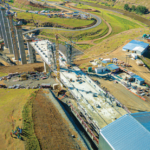The long-anticipated Senqu Bridge in Mokhotlong is inching closer to completion, with the Lesotho Highlands Development Authority (LHDA) announcing that the towering structure will be ready by February 2026, a few months later than its initial November 2025 deadline.
By the end of July 2025, construction stood at 86 percent complete, with the bridge already commanding attention as a monumental feat of engineering.
Stretching 825 meters in length and rising 90 meters high, the Senqu Bridge will not only be the tallest in Lesotho, but also the tallest bridge on the African continent. Supported by 15 piers ranging from 15 to 90 meters, the bridge is designed to last over a century.
The Senqu Bridge is one of three bridges being built under Phase II of the Lesotho Highlands Water Project (LHWP), alongside the Mabunyane and Khubelu bridges, constructed at a combined cost of M500 million.
The Senqu Bridge alone comes at a staggering M2.3 billion.
According to the Resident Chief Engineer Louis Joubert of Zutari, Senqu Bridge lifespan is over 100 years. Zutari has been engaged as the consultant of the three bridges. Joubert said when Polihali Dam is full, its water will rise up to five meters of the bridge’s highest point.
He mentioned that it will also feature a pedestrian walkway, which will be barricaded to prevent people from jumping into the water to commit suicide. The bridge design started in 2018, and the contract for the construction was awarded in November 2022 and the actual construction took place in April 2023.
The Chief Resident Engineer said about six months were lost also due to strike and during the initial phase of the construction. The LHDA stated that if this bridge would not have been constructed, it would be difficult for the people of Mokhotlong to access the town.
The Polihali reservoir, located in the valleys and tributary catchments of the Senqu, Khubelu, Mokhotlong, Moremoholo, and Sehong-hong rivers, will be created by the construction of the Polihali Dam. It is going to cover a surface area of about 5,000 hectares.
About 1 300 people had been employed, and now there are reportedly 800 people on the site, the number which is expected to dwindle as much of the work will be done by machinery.
The LHDA has awarded the contract for building the Senqu Bridge to the WRES Senqu Bridge Joint Venture. The WRES Joint Venture includes companies from South Africa, Lesotho, and other countries, as required by the Phase II Agreement.
The main partners are Webuild S.p.A. from Italy, Raubex Construction (Pty) Ltd from South Africa, Enza Construction (Pty) Ltd from South Africa, and Sigma Construction (Pty) Ltd from Lesotho. The subcontractors are EXR Construction (Pty) Ltd from South Africa, Gleitbau-Gesellschaft from Austria, Post Tensioning and Structural Solutions (Pty) Ltd from South Africa, and Freyssinet International et Cie from France.
The bridge design has taken into account the long, cold, and harsh winter conditions of the Mokhotlong highlands. The two bridges, Mabunyane and Khubelu bridges have been built at a cost of M500 million.
The supervising consultant, Resident Engineer Junno Van der Merve, assured that the progress is going well, and they are expected to be completed soon.
“Experience and expertise are crucial in delivering a sophisticated, technically challenging project of this kind, which will be a first for the LHWP and Lesotho. With its unique features, the Senqu Bridge will not only form part of the safe and efficient road infrastructure network constructed under Phase II but will be a major tourist attraction contributing to long term benefits in stimulating sustainable economic growth,” said Ntsoli Maiketso, the Phase II Divisional Manager.
Summary
- Stretching 825 meters in length and rising 90 meters high, the Senqu Bridge will not only be the tallest in Lesotho, but also the tallest bridge on the African continent.
- The Polihali reservoir, located in the valleys and tributary catchments of the Senqu, Khubelu, Mokhotlong, Moremoholo, and Sehong-hong rivers, will be created by the construction of the Polihali Dam.
- With its unique features, the Senqu Bridge will not only form part of the safe and efficient road infrastructure network constructed under Phase II but will be a major tourist attraction contributing to long term benefits in stimulating sustainable economic growth,” said Ntsoli Maiketso, the Phase II Divisional Manager.

Thoboloko Ntšonyane is a dedicated journalist who has contributed to various publications. He focuses on parliament, climate change, human rights, sexual and reproductive health rights (SRHR), health, business and court reports. His work inspires change, triggers dialogue and also promote transparency in a society.






